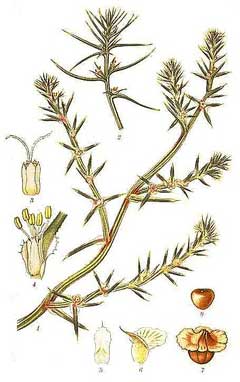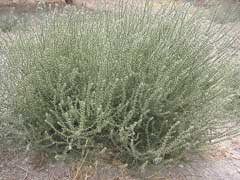 |
|
http://commons.wikimedia.org/wiki/File:354_Salsola_kali.jpg |
 |
| http://commons.wikimedia.org/wiki/User:Alberto_Salguero |
Translate this page:
Summary
Physical Characteristics

 Salsola kali is a ANNUAL growing to 0.6 m (2ft). It is in flower from July to September, and the seeds ripen from August to October. The species is hermaphrodite (has both male and female organs) and is pollinated by Wind.
Salsola kali is a ANNUAL growing to 0.6 m (2ft). It is in flower from July to September, and the seeds ripen from August to October. The species is hermaphrodite (has both male and female organs) and is pollinated by Wind.
Suitable for: light (sandy) and medium (loamy) soils and prefers well-drained soil. Suitable pH: mildly acid, neutral and basic (mildly alkaline) soils and can grow in very alkaline and saline soils.
It cannot grow in the shade. It prefers dry or moist soil. The plant can tolerate maritime exposure.
UK Hardiness Map
US Hardiness Map
Synonyms
Plant Habitats
Cultivated Beds;
Edible Uses
Edible Parts: Leaves Seed
Edible Uses:
Young leaves and stems - raw or cooked[46, 61, 62, 105]. An excellent food[85] with a crunchy tender texture[206]. The leaves can be used as a spinach substitute or added in small quantities to salads[9]. Seed - cooked. It can be ground into a meal and used as a gruel, thickener in soups etc or added to cereal flours when making bread etc[85]. The seed is small and hard to collect any quantity[85].
References More on Edible Uses
Medicinal Uses
Plants For A Future can not take any responsibility for any adverse effects from the use of plants. Always seek advice from a professional before using a plant medicinally.
Cathartic Diuretic Emmenagogue Stimulant Vermifuge
The juice of the fresh plant is an excellent diuretic[4]. The seedpods can also be used[4]. Salsolin, one of the constituents of the plant, has been used to regulate the blood pressure. It is said to resemble papaverine in its effect on vasoconstriction and hydrastine in its effect on the smooth muscles of the uterus[269]. Reported to be cathartic, diuretic, emmenagogue, stimulant, and vermifuge, the plant is a folk remedy for dropsy and excrescences[269].
References More on Medicinal Uses
The Bookshop: Edible Plant Books
Our Latest books on Perennial Plants For Food Forests and Permaculture Gardens in paperback or digital formats.

Edible Tropical Plants
Food Forest Plants for Hotter Conditions: 250+ Plants For Tropical Food Forests & Permaculture Gardens.
More

Edible Temperate Plants
Plants for Your Food Forest: 500 Plants for Temperate Food Forests & Permaculture Gardens.
More

More Books
PFAF have eight books available in paperback and digital formats. Browse the shop for more information.
Shop Now
Other Uses
Biomass Cleanser Potash
The ashes of the burnt plant are used for making glass and soap[100]. At one time large quantities of the ashes were imported into Britain for this purpose, but nowadays a chemical process using salt is employed[4]. The ashes can also be used as a cleaner for fabrics[169]. As a low-water-use plant, germinating quickly on minimally disturbed soils, and relatively free of diseases and parasites, this has been suggested as a fuel source for arid lands[269]. Yields of around 3 tonnes per hectare of plant material have been achieved[269]. Dynamic accumulator.
Special Uses
Dynamic accumulator
References More on Other Uses
Cultivation details
Requires a very sunny position in a light or medium well-drained soil. Tolerates maritime exposure. The plant is reported to tolerate an annual precipitation in the range of 26 to 97cm, an annual temperature in the range of 9.2 to 23.8°C and a pH of 7.0 to 7.9[269]. This species was seen growing in a sunny bed at Cambridge Botanical Gardens in 1987, we have also grown it on a number of occasions[K]. This species is listed as a serious weed in many countries of the world[269].
References Carbon Farming Information and Carbon Sequestration Information
Temperature Converter
Type a value in the Celsius field to convert the value to Fahrenheit:
Fahrenheit:
The PFAF Bookshop
Plants For A Future have a number of books available in paperback and digital form. Book titles include Edible Plants, Edible Perennials, Edible Trees,Edible Shrubs, Woodland Gardening, and Temperate Food Forest Plants. Our new book is Food Forest Plants For Hotter Conditions (Tropical and Sub-Tropical).
Shop Now
Plant Propagation
Seed - sow spring in situ. The seed has a short viability and should be stored cool over the winter[206].
Other Names
If available other names are mentioned here
Native Range
EUROPE: Denmark, Finland (south), United Kingdom, Ireland, Norway (south), Sweden (south), Belgium, Germany (north), Hungary, Netherlands (north), Poland (north), Estonia, Lithuania, Latvia, Russian Federation (Kaliningrad, Leningradskaja oblast), Spain, France (n. & w.), Portugal
Weed Potential
Right plant wrong place. We are currently updating this section.
Please note that a plant may be invasive in one area but may not in your area so it's worth checking.
Conservation Status
IUCN Red List of Threatened Plants Status :

Growth: S = slow M = medium F = fast. Soil: L = light (sandy) M = medium H = heavy (clay). pH: A = acid N = neutral B = basic (alkaline). Shade: F = full shade S = semi-shade N = no shade. Moisture: D = dry M = Moist We = wet Wa = water.
Now available:
Food Forest Plants for Mediterranean Conditions
350+ Perennial Plants For Mediterranean and Drier Food Forests and Permaculture Gardens.
[Paperback and eBook]
This is the third in Plants For A Future's series of plant guides for food forests tailored to
specific climate zones. Following volumes on temperate and tropical ecosystems, this book focuses
on species suited to Mediterranean conditions—regions with hot, dry summers and cool, wet winters,
often facing the added challenge of climate change.
Read More
Expert comment
Author
L.
Botanical References
17
Links / References
For a list of references used on this page please go here
Readers comment
| Add a comment |
|
If you have important information about this plant that may help other users please add a comment or link below. Only comments or links that are felt to be directly relevant to a plant will be included. If you think a comment/link or information contained on this page is inaccurate or misleading we would welcome your feedback at [email protected]. If you have questions about a plant please use the Forum on this website as we do not have the resources to answer questions ourselves.
* Please note: the comments by website users are not necessarily those held by PFAF and may give misleading or inaccurate information.
To leave a comment please Register or login here All comments need to be approved so will not appear immediately.
|
|